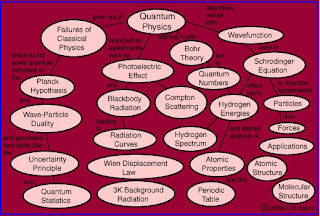
When x-rays are scattered from a crystal lattice, peaks of scattered intensity are observed which correspond to the following conditions:
The angle of incidence = angle of scattering.The pathlength difference is equal to an integer number of wavelengths.
The condition for maximum intensity contained in Bragg's law above allow us to calculate details about the crystal structure, or if the crystal structure is known, to determine the wavelength of the x-rays incident upon the crystal.
A continuación un pequeño programa para calculos de longitud:
Para mayor información seguir el siguiente enlace, es muy práctico.
Bragg Spectrometer
Much of our knowledge about crystal structure and the structure of molecules as complex as DNA in crystalline form comes from the use of x-rays in x-ray diffraction studies. A basic instrument for such study is the Bragg spectrometer.
To obtain nearly monochromatic x-rays, an x-ray tube is used to produce characteristic x-rays. In order to eliminate as much of the brehmsstrahlung continuum radiation as possible, matched filters are used in the x-ray beam to optimize the fraction of the energy which is in the K-alpha line. Such filters use elements just above and just below the metal in the x-ray target, making use of the strong "absorption edges" just above and below the K-alpha energy of the target metal.
The x-rays are collimated with apertures in a strong x-ray absorber (usually lead) and the narrow resulting x-ray beam is allowed to strike the crystal to be studied. The spectrometer arrangement couples the rotation of the crystal with the rotation of the detector so that the angle of rotation of the detector is twice that of the crystal. This satisfies the conditions of Bragg's law for diffraction of the x-rays from the crystal lattice planes.
The x-rays are collimated with apertures in a strong x-ray absorber (usually lead) and the narrow resulting x-ray beam is allowed to strike the crystal to be studied. The spectrometer arrangement couples the rotation of the crystal with the rotation of the detector so that the angle of rotation of the detector is twice that of the crystal. This satisfies the conditions of Bragg's law for diffraction of the x-rays from the crystal lattice planes.
Characteristic X-Rays
Characteristic x-rays are emitted from heavy elements when their electrons make transitions between the lower atomic energy levels. The characteristic x-rays emission which shown as two sharp peaks in the illustration at left occur when vacancies are produced in the n=1 or K-shell of the atom and electrons drop down from above to fill the gap. The x-rays produced by transitions from the n=2 to n=1 levels are called K-alpha x-rays, and those for the n=3->1 transiton are called K-beta x-rays.
Transitions to the n=2 or L-shell are designated as L x-rays (n=3->2 is L-alpha, n=4->2 is L-beta, etc. ). The continuous distribution of x-rays which forms the base for the two sharp peaks at left is called "bremsstrahlung" radiation.
X-ray production typically involves bombarding a metal target in an x-ray tube with high speed electrons which have been accelerated by tens to hundreds of kilovolts of potential. The bombarding electrons can eject electrons from the inner shells of the atoms of the metal target. Those vacancies will be quickly filled by electrons dropping down from higher levels, emitting x-rays with sharply defined frequencies associated with the difference between the atomic energy levels of the target atoms.
The frequencies of the characteristic x-rays can be predicted from the Bohr model . Moseley measured the frequencies of the characteristic x-rays from a large fraction of the elements of the periodic table and produces a plot of them which is now called a "Moseley plot".
Characteristic x-rays are used for the investigation of crystal structure by x-ray diffraction. Crystal lattice dimensions may be determined with the use of Bragg's law in a Bragg spectrometer.
Brillouin Scattering
Scattering of light from acoustic modes is called Brillouin scattering. From a strictly classical point of view, the compression of the medium will change the index of refraction and therefore lead to some reflection or scattering at any point where the index changes. From a quantum point of view, the process can be considered one of interaction of light photons with acoustic or vibrational quanta (phonons). Two examples will provide some context for this phenomenon.
Fisica Cuántica
Orlaning Colmenares
C.I.V.- 18.991.089
Referencia Bibliografica:
Get news, entertainment and everything you care about at Live.com. Check it out!




Several different velocimetry techniques are used at Idaho National Laboratory's MIR Lab including Laser Doppler Velocimetry (LDV), Particle Image Velocimetry (PIV), High speed PIV and Stereoscopic PIV.The MIR Lab is exploring the addition of planar laser induced fluorescence (PLIF). This is a stereoscopic method of measuring the concentrations and velocity fields and flow visualization of multiphase or multispecies flows.
ResponderEliminarhttp://www.inl.gov/velocimetry